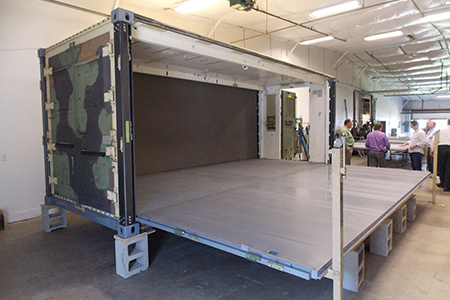Retrofit Kit Remedies Inadequacies in Aging Rigid Wall Shelters

After more than 20 years in the field, Rigid Wall Shelters, an integral part of Army Field Hospitals, are starting to show their age. There are problems with stability, transportation issues and the need for more energy efficiency. The U.S. Army Medical Materiel Development Activity's Medical Support Systems Project Management Office has found a solution to meet those needs.
An RWS starts out as a 20 feet long, 8 feet high, and 8 feet wide container and unfolds to triple in size, providing a floor, ceiling and four walls. It is a very efficient design, which maximizes available floor space and can be set up by four to six people in less than an hour. However, because the RWS is made of aluminum, which enables the shelter to be light-weight, it has its downfalls.
Working in coordination with Melvin Jee and Roger Masadi of the Tactical Shelters Team, U.S. Army Natick Soldier Research, Development & Engineering Center and also Core Composites, a division of ROM Development Corporation in Bristol, Rhode Island, the MSS PMO will use a carbon composite retrofit kit to refurbish the current shelters and address the deficiencies.
"Carbon composite [carbon fibers coated in resin] is two times stiffer and overall the shelter will be 20 percent lighter than the current aluminum design," said Richard O'Meara of Core Composites, a division of ROM Development Corporation.
The RWSs are used for the core parts of the hospital, housing the operating room, the C-arm [portable radiology], and the laboratory; where the floor needs to be stable and free of vibration.
According to Jaime Lee, MSS PMO product manager, "Instability has always been an issue. We kind of fixed it by placing scissor-jacks underneath the middle section of the shelter. This works for a while until the ground settles."
The kit provides a single fixed floor with two expandable floors. Now that they are made of carbon composite, they are double the stiffness of the previous floors, which makes them less susceptible to unwanted vibration.
Also included are four vertical corner posts fabricated out of carbon composite. Each post only weighs 50 pounds as opposed to the current aluminum post which weighs 71 pounds. These posts bear the load of additional containers stacked on top of the shelter. Currently, each aluminum corner post is designed to support 100,800 pounds, which allows for the shipping containers to be transported in a six-high stack. The carbon composite corner posts are designed to meet the current transportation standards which require each corner post to support 211,675 pounds in order to withstand the weight of eight shipping containers resulting in a nine-high stack. This increased capability improves transportation efficiency and will reduce the cost of shipping.
Additionally, when taken as a whole, the reduced panel and corner post weights serve to lower the overall empty shelter weight by several hundred pounds. This allows for an increase in the amount of cargo the shelter can carry.
According to O'Meara, the posts are also much more corrosion resistant than the current aluminum posts that corrode when in contact with the steel corner fittings.
In the past, shelter refurbishment has involved more of a facelift approach in that the floors are redone, and the shelter is painted and resealed. Now, Core Composites, a division of ROM Development Corporation, will make the retrofit kits and send them to Defense Depot Hill Utah. There, the original shelter will be disassembled and over half of the major components will then be replaced with the new kit.
Also, since current shelters are not energy efficient, Tnemec's Aerolon 945 will be applied to the ceiling as either a sprayed-on coating or a peel-and-stick "wallpaper," which will help provide better insulation thereby reducing heat and cold loss through the top of the shelter. This will double the insulation efficiency of the shelter.
According to Lee, retrofitting 24 shelters using FY16 funding will begin in FY17 and continue with 24 shelter retrofits per year, subject to availability of funding.
"We are procuring the kits now as an Engineering Change Proposal to the original shelter," said Lee. "In two years we will reassess and do a cost-benefit analysis to see if we should just replace the entire shelter with a carbon composite shelter. It might be just as cost-effective to stay with the kit."
Either way, carbon composites are the future. Whereas aluminum is a limited resource with inadequate capabilities, carbon composite as a building material is more abundant, stronger and lighter. Carbon composite also has more possible applications and producing it leaves a smaller carbon dioxide footprint.













